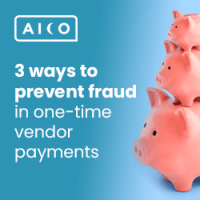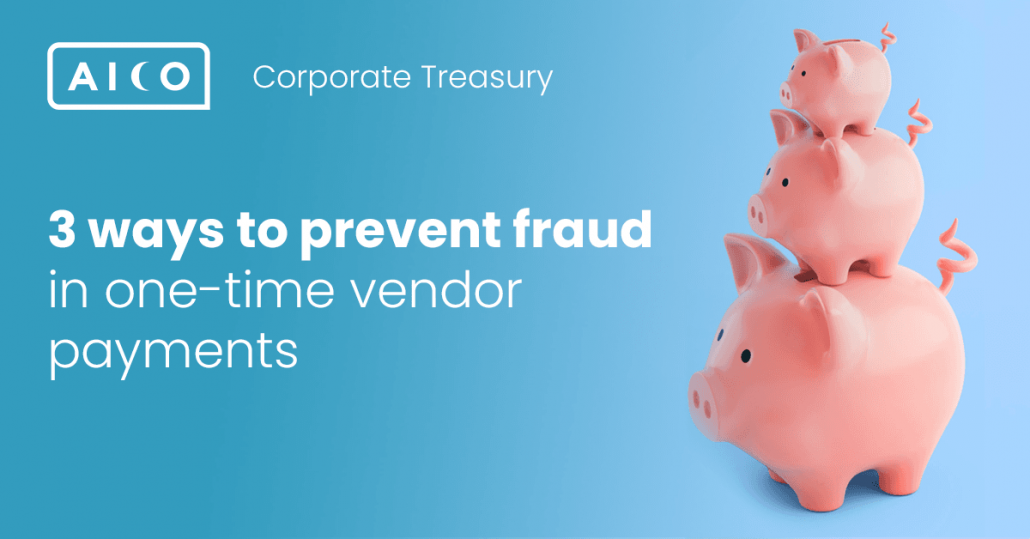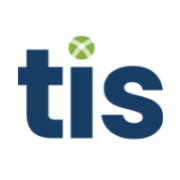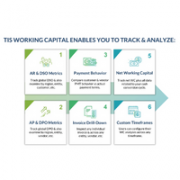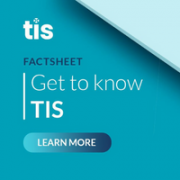Corporate Treasury: 3 ways to prevent fraud risk in one-time vendor payments
09-02-2022 | treasuryXL | Aico | LinkedIn |
Manual payments are somewhat of an outlier among corporate treasury payments. These one-time vendor transactions to companies or private individuals whose details are not in your ERP system pose a significant risk of fraud. They are challenging to track and easy to manipulate in an enterprise environment. This makes them a target for auditors, who want to clearly see you have monitored all points in the payment process where data can be altered. Changing the payment details or falsifying invoices are just a couple of mishandling examples, leading to massive fraud cases like these.
There is, however, a transparent and secure way to handle these payments as quickly and efficiently as the typical accounts payable invoice automation process.
Let’s look at three preventative solutions to reduce the fraud risk.
1. Enforce approval workflows: The four-eye principle.
Much of payment fraud originates in transferring small sums to non-existing vendors, rather than large payments. It makes such transactions much harder to identify and match over a long period.
The so-called four-eye principle is one of the cornerstones of a preventative approach to fraud management and internal controls in general. Having no means to enforce payment approval workflows across the group’s companies with little to no visibility into initiated payments is a challenge many enterprises struggle with.
A software solution to enforce systemic payment approvals is essential. And so is the ability to easily customise these workflows and apply them to the whole company group in line with your internal and external compliance guidelines.
You may want to enforce one or two-step payment approvals based on value or frequently recurring IBAN details. A mandatory requirement to add an attachment of supporting evidence is another possibility. These are just some examples of how a modern software solution like Aico can help you minimise fraud risk effectively.
2. Secure PAIN file creation and bank transfers.
A holistic approach is essential for effectively implementing internal controls against payment fraud. Eliminating 90% of a leak in your boat still leaves you at high risk. So, payment approvals alone will make it harder to start a fraudulent payment, but they won’t secure you from trickery further down the process.
Once one or more people have approved the payment, it will be sent to the bank in a PAIN (payment initiation) file format. The data in the approved payment request should be identical to the one in the PAIN file. Eliminating any possibility to create or alter the PAIN file manually is the single most effective protection in this part of the process. So ideally, PAIN file creation and transfer to the bank should be fully automated.
In the case of the Aico Manual Payments software solution, the system will create the PAIN file automatically in the background using the master data of the approved payment request. Once approved, the PAIN file goes automatically to the bank for the payment without any further human interaction.
3. Automate journal postings.
Verifying the execution of the payment and accounting for it in a compliant way is the last, but not least, important part of the safe payment process. Just as we want to ensure the bank receives the approved payment document, it is equally important to match the returning bank statement with the original payment order.
And once again, an automated process is the safest solution. In fact, at this point, we can also securely manage the accounting by automatically creating and posting a journal entry into the ERP system. Automation here saves us time and ensures that subsequent journals are posted to the correct accounts with the right value matching the master data of the initially approved payment request.
Is it possible to take one more step to safeguard this process?
In addition to the smart workflows and powerful automation, the Aico Manual Payments solution will also archive the entire activity log and documents related to the specific payment. This extra mile of effort will significantly simplify the audit process and help to identify any irregularities.

About Aico
We help enterprises simplify financial close and record-to-report (R2R) accounting processes. The result is less manual work and faster period-end financial reporting with the assurance of compliance and data accuracy.
Our software platform includes solutions for the key R2R processes – Account Reconciliation, Closing Task Management, Journal Entries, Intercompany Invoicing and Manual Payments.
Unique real-time integration to multiple ERP systems brings increased automation levels and reduces IT system complexity to our customers.
With teams and a network of partners across EMEA, we deliver high-complexity projects for enterprises with a global footprint.
Visit aico.ai for more information about Aico.
Visit Aico resource library for eBooks and webinars on R2R and financial close best practices.
Join us on LinkedIn.

